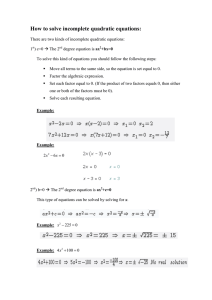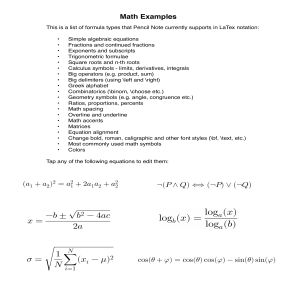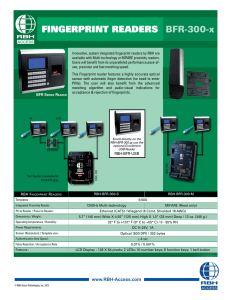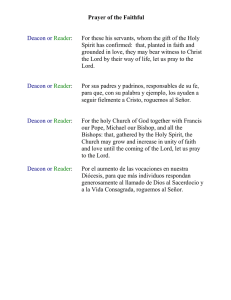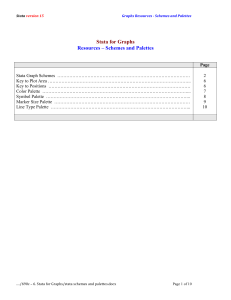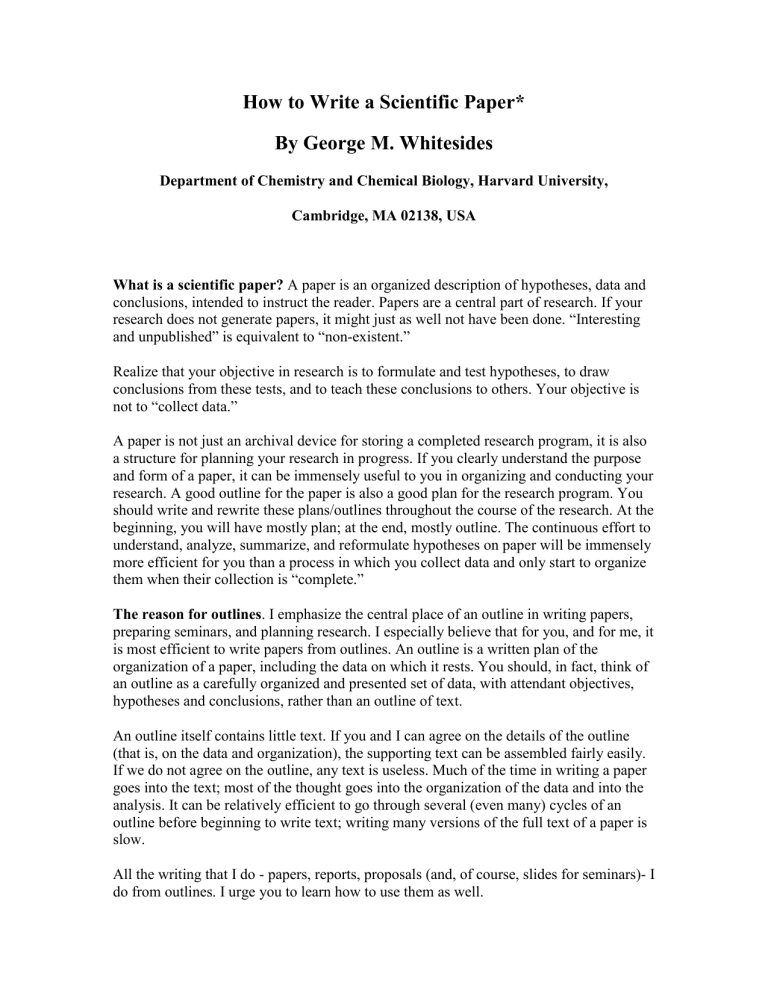
How to Write a Scientific Paper* By George M. Whitesides Department of Chemistry and Chemical Biology, Harvard University, Cambridge, MA 02138, USA What is a scientific paper? A paper is an organized description of hypotheses, data and conclusions, intended to instruct the reader. Papers are a central part of research. If your research does not generate papers, it might just as well not have been done. “Interesting and unpublished” is equivalent to “non-existent.” Realize that your objective in research is to formulate and test hypotheses, to draw conclusions from these tests, and to teach these conclusions to others. Your objective is not to “collect data.” A paper is not just an archival device for storing a completed research program, it is also a structure for planning your research in progress. If you clearly understand the purpose and form of a paper, it can be immensely useful to you in organizing and conducting your research. A good outline for the paper is also a good plan for the research program. You should write and rewrite these plans/outlines throughout the course of the research. At the beginning, you will have mostly plan; at the end, mostly outline. The continuous effort to understand, analyze, summarize, and reformulate hypotheses on paper will be immensely more efficient for you than a process in which you collect data and only start to organize them when their collection is “complete.” The reason for outlines. I emphasize the central place of an outline in writing papers, preparing seminars, and planning research. I especially believe that for you, and for me, it is most efficient to write papers from outlines. An outline is a written plan of the organization of a paper, including the data on which it rests. You should, in fact, think of an outline as a carefully organized and presented set of data, with attendant objectives, hypotheses and conclusions, rather than an outline of text. An outline itself contains little text. If you and I can agree on the details of the outline (that is, on the data and organization), the supporting text can be assembled fairly easily. If we do not agree on the outline, any text is useless. Much of the time in writing a paper goes into the text; most of the thought goes into the organization of the data and into the analysis. It can be relatively efficient to go through several (even many) cycles of an outline before beginning to write text; writing many versions of the full text of a paper is slow. All the writing that I do - papers, reports, proposals (and, of course, slides for seminars)- I do from outlines. I urge you to learn how to use them as well. How should you construct an outline? The classical approach is to start with a blank piece of paper, and write down, in any order, all important ideas that occur to you concerning the paper. Ask yourself the obvious questions:“Why did I do this work?” “What does it mean?”“What hypothesis did I mean to test?”“What ones did I actually test?”“What were the results?”“Did the work yield a new method or compound? What?”“What measurements did I make?”“What compounds? How were they characterized?” Sketch possible equations, figures, and schemes. It is essential to try to get the major ideas written down. If you start the research to test one hypothesis, and decide, when you see what you have, that the data really seem to test some other hypothesis better, don't worry. Write them both down, and pick the best combinations of hypotheses, objectives and data. Often the objectives of a paper when it is finished are different from those used to justify starting the work. Much of good science is opportunistic and revisionist. When you have written down what you can, start with another piece of paper and try to organize the jumble of the first one. Sort all of your ideas into three major heaps (A-C). A) Introduction Why did I do the work? What were the central motivations and hypotheses? B) Results and Discussion What were the results? How were compounds made and characterized? What was measured? C) Conclusions What does it all mean? What hypotheses were proved or disproved? What did I learn? Why does it make a difference? Next, take each of these sections, and organize it on yet finer scale. Concentrate on organizing the data. Construct figures, tables, and schemes to present the data as clearly and compactly as possible. This process can be slow - I may sketch a figure 5-10 times in different ways, trying to decide how it is most clear (and looks best aesthetically). Finally, put everything—outline of sections, tables, sketches of figures, equations - in good order. When you are satisfied that you have included all the data (or that you know what additional data you intend to collect), and have a plausible organization, give the outline to me. Simply indicate where missing data will go, how you think (hypothesize) they will look, and how you will interpret them if your hypothesis is correct. I will take this outline, add my opinions, suggest changes, and return it to you. It usually takes 4-5 repeated attempts (often with additional experiments) to agree on an outline. When we have agreed, the data are usually in (or close to) final form (that is, the tables, figures, etc., in the outline will be the tables, figures,…in the paper.) You can then start writing, with some assurance that much of your prose will be used. The key to efficient use of your and my time is that we start exchanging outlines and proposals as early in a project as possible. Do not, under any circumstances, wait until the collection of data is “complete” before starting to write an outline. No project is ever complete, and it saves enormous effort and much time to propose a plausible paper and outline as soon as you see the basic structure of a project. Even if we decide to do significant additional work before seriously organizing a paper, the effort of writing an outline will have helped to guide the research. The outline What should an outline contain? Title: Authors: Abstract: Do not write an abstract. That can be done when the paper is complete. Introduction: The first paragraph or two should be written out completely. Pay particular attention to the opening sentence. Ideally, it should state concisely the objective of the work, and indicate why this objective is important. In general, the Introduction should have these elements: The objectives of the work. The justification for these objectives: Why is the work important? Background: Who else has done what? How? What have we done previously? Guidance to the reader. What should the reader watch for in the paper? What are the interesting high points? What strategy did we use? Summary conclusion. What should the reader expect as conclusion? In advanced versions of the outline, you should also include all the sections that will go in the Experimental section (at this point, just as paragraph subheadings). Results and Discussion. The results and discussion are usually combined. This section should be organized according to major topics. The separate parts should have subheadings in boldface to make this organization clear, and to help the reader scan through the final text to find the parts that interest him or her. The following list includes examples of the phrases that might plausibly serve as section headings: Synthesis of Alkane Thiols Characterization of Monolayers Absolute Configuration of the Vicinal Diol Unit Hysteresis Correlates with Roughness of the Surface Dependence of the Rate Constant on Temperature The Rate of Self-Exchange Decreases with the Polarity of the Solvent Try to make these section headings as specific and information-rich as possible. For example, the phrase “The Rate of Self-Exchange Decreases with The Polarity of The Solvent” is obviously longer than “Measurement of Rates,” but much more useful to the reader. In general, try to cover the major common points: “The Rate of Self-Exchange Decreases with The Polarity of The Solvent” Synthesis of starting materials Characterization of products Methods of characterization Methods of measurement Results (rate constants, contact angles, whatever) In the outline, do not write any significant amount of text, but get all the data in their proper place: any text should simply indicate what will go in that section. Section Headings Figures (with captions) Schemes (with captions and footnotes) Equations Tables (correctly formatted) Remember to think of a paper as a collection of experimental results, summarized as clearly and economically as possible in figures, tables, equations, and schemes. The text in the paper serves just to explain the data, and is secondary. The more information that can be compressed into tables, equations, etc., the shorter and more readable the paper will be. Conclusion. In the outline, summarize the conclusions of the paper as a list of short phrases or sentences. Do not repeat what is in the Results section, unless special emphasis is needed. The Conclusions section should be just that, and not a summary. It should add a new, higher level of analysis, and should indicate explicitly the significance of the work. Experimental. Include, in the correct order to correspond to the order in the Results section, all of the paragraph subheadings of the Experimental section. In summary: - Start writing possible outlines for papers early in a project. Do not wait until the “end”. The end may never come. - Organize the outline and the paper around easily assimilated data - tables, equations, figures, schemes - rather than around text. - Organize in order of importance, not in chronological order. An important detail in writing paper concerns the weight to be given to topics. Neophytes often organize a paper in terms of chronology: that is, they recount their experimental program, starting with their cherished initial failures and leading up to a climactic successful finale. This approach is completely wrong. Start with the most important results, and put the secondary results later, if at all. The reader usually does not care how you arrived at your big results, only what they are. Shorter papers are easier to read than longer ones. Some Points of English Style 1) Do not use nouns as adjectives: ATP formation formation of ATP reaction product product of the reaction 2) The word “this” must always be followed by a noun, so that its reference is explicit this is a fast reaction this reaction is fast this leads us to conclude this observation leads us to conclude 3) Describe experimental results uniformly in the past tense. Addition of water gives addition of water gave product product 4) Use the active voice whenever possible. It was observed that the solution turned red. The solution turned red Or We observed that the solution turned red. 5) Complete all comparisons. The yield was higher using The yield was higher using bromine bromine than chlorine. 6) Type all papers double-spaced (not single-or one-and-a-half spaced), and leave 1 space after colons, commas, and after periods at the end of sentences. Leave generous margins. (generally, 1.25” on both sides & top & bottom). Assume that we will write all papers using the style of the American Chemical Society. You can get a good idea of this style from three sources: 1) The Journal. Simply look at articles in the journals and copy the organization you see there. 2) Previous papers from the group. By looking at previous papers, you can see exactly how a paper should “look”. If what you wrote looks different, it probably is not what we want. 3) The ACS Style Guide: A Manual for Authors and Editors. (Janet S. Dodd, Editor Washington, D.C. USA 1997) . Useful detail, especially the section on references. I also suggest you read Strunk and White, The Elements of Style (Longman: New York, 2000, 4th edition) to get a sense for English usage. Two excellent books on the design of graphs and figures are: “The Visual Display of Quantitative Information” by Edward R. Tufte, Graphics Press (1983) and “Envisioning Information” also by Edward R. Tufte, Graphics Press (1990). *Originally written for the group of Whitesides, and the English polished further by Barbara Whitesides
